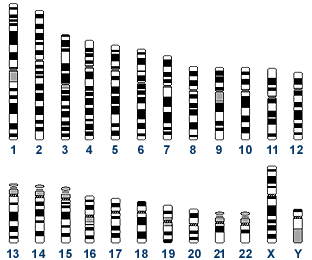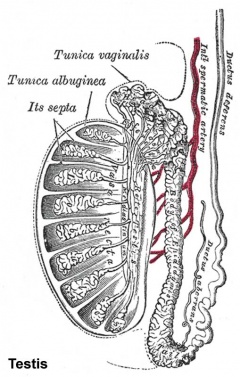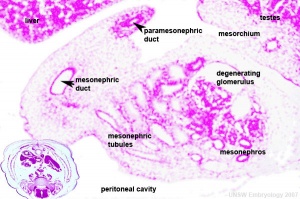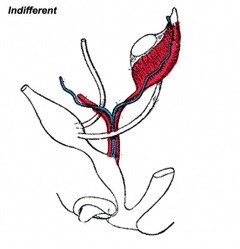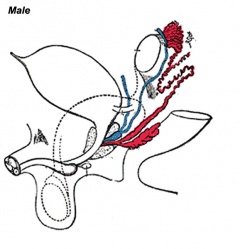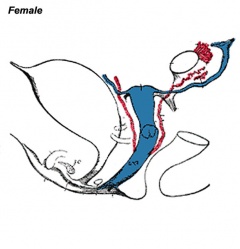2009 Lecture 16: Difference between revisions
| Line 70: | Line 70: | ||
===Female (XX)=== | ===Female (XX)=== | ||
* 1400+ genes, 150 million base pairs | |||
* In contrast to the Y chromosome, the X chromosome contains about 5% of the haploid genome and encodes house-keeping and specialized functions. The genetic content of the X chromosome has been strongly conserved between species. | * In contrast to the Y chromosome, the X chromosome contains about 5% of the haploid genome and encodes house-keeping and specialized functions. The genetic content of the X chromosome has been strongly conserved between species. | ||
Revision as of 22:31, 21 September 2009
Genital Development
Introduction
This section of notes covers genital development. Differences in development are dependent on a protein product of the Y chromosome SRY gene. Mesonephric duct (Wolffian Duct) and paramesonephric (Mullerian Duct) contribute the majority of male and female internal genital tract respectively.
Objectives
- Understand the role of the Y chromosome in sex determination.
- Understand the differences in male/female duct develpoment (mesonephric/paramesonephric).
- Compare the development of the cloaca in the male and female.
- Understand the developmental abnormalities in male and female development.
Textbooks
- Human Embryology (2nd ed.) Larson Ch10 p261-306
- The Developing Human: Clinically Oriented Embryology (6th ed.) Moore and Persaud Chapter 13 p303-346
Three Stages
The mesonephric/paramesonephric duct changes are one of the first male/female differences that occur in development, while external genitaila remain indeterminate in appearance for quite a while.
- Differentiation of gonad (Sex determination)
- Differentiation of internal genital organs
- Differentiation of external genital organs
The 2nd and 3rd stages dependent on endocrine gonad. Reproductive development has a long maturation timecourse, begining in the embryo and finishing in puberty. (More? Puberty)
Development Overview
Sex Determination
- Humans (week 5-6)
- Germ cells migrate into gonadal ridge
- Gonads (male/female) identical at this stage, indifferent
Gonad development
- dependent on sex chromosome
- Y testes
- No Y ovary
SRY
- SRY protein (Testes determining factor, TDF) binds DNA
- Transcription factor, Bends DNA 70-80 degrees
Internal Genital Organs
- All embryos form paired
- Mesonephric duct, see kidney development
- Paramesonephric duct, Humans 7th week Invagination of coelomic epithelium Cord grows and terminates on urogenital sinus
- Male Gonad (testes) secretes Mullerian duct inhibitory factor (MDIF) which causes regression of paramesonephric duct
- Male Gonad (testes) secretes Testosterone which retains mesonephric duct
External Genital Organs
- All embryos initially same (indifferent)
- Testosterone differentiates male
Sex Determination
Male (XY)
- Y chromosome - 200+ genes, 50 million base pairs
- Sry was discovered (1990) by studying a human XY female, resulting from a deletion in the Y chromosome that did not allow testis development. Subsequent mapping of this deletion allowed isolation and characterization of the SRY gene.
- SRY encodes: encodes a 204 amino acid protein (Mr 23884 Da) that is a zinc-finger transcription factor. Transcription factors bind to specific sites of DNA and regulates the transcription (expression) of other genes, we still do not know all the genes SRY regulates.
- SRY is expressed: when testes begin to form, in gonadal tissue and does not require the presence of germ cells.
Female (XX)
- 1400+ genes, 150 million base pairs
- In contrast to the Y chromosome, the X chromosome contains about 5% of the haploid genome and encodes house-keeping and specialized functions. The genetic content of the X chromosome has been strongly conserved between species.
- An early discovery (1961) was that in order to have correct levels of X chromosome gene/protein expression (gene dosage), females must "inactivate" a single copy of the X chromosome in each and every cell. The initiator of the X inactivation process was discovered (1991) to be regulated by a region on the inactivating X chromosome encoding an X inactive specific transcript (XIST), that acts as RNA and does not encode a protein.
- X inactivation occurs randomly throughout the embryo, generating a mosaic of maternal and paternally derived X chromosome activity in all tissues and organs.
Primordial Germ Cells
- thought to be the first population of cells to migrate through the primitive streak in early gastrulation.
- This population of cells then lie at the hindgut yolk sac junctional region and later migrate into the germinal ridge in early embryonic development.
- It is not the primordial germ cells which respond to SRY presence or absence, but the supporting cells within the developing gonad.
References
- Before We Are Born (5th ed.) Moore and Persaud Chapter 14 p289-326
- Essentials of Human Embryology, Larson Ch10 p173-205
- Human Embryology, Fitzgerald and Fitzgerald Ch21-22 p134-152
- Developmental Biology (6th ed.) Gilbert Ch14 Intermediate Mesoderm
Online Links
- UNSW Embryology Abnormalities | Y chromosome | X chromosome | Ovary | Stage 13/14 Embryo | Stage 22 Embryo | Stage 22 Highpower
- UNSW Embryology Movies: Urogenital Movies
- Embryo Images Unit: Embryo Images Online | Urongenital Development | Internal Genitalia | Definitive Kidney | External Genitalia
- Histology: Male Reproductive System | Female Reproductive System
Glossary Links
- Glossary: A | B | C | D | E | F | G | H | I | J | K | L | M | N | O | P | Q | R | S | T | U | V | W | X | Y | Z | Numbers | Symbols | Term Link
Course Content 2009
Embryology Introduction | Cell Division/Fertilization | Cell Division/Fertilization | Week 1&2 Development | Week 3 Development | Lab 2 | Mesoderm Development | Ectoderm, Early Neural, Neural Crest | Lab 3 | Early Vascular Development | Placenta | Lab 4 | Endoderm, Early Gastrointestinal | Respiratory Development | Lab 5 | Head Development | Neural Crest Development | Lab 6 | Musculoskeletal Development | Limb Development | Lab 7 | Kidney | Genital | Lab 8 | Sensory - Ear | Integumentary | Lab 9 | Sensory - Eye | Endocrine | Lab 10 | Late Vascular Development | Fetal | Lab 11 | Birth, Postnatal | Revision | Lab 12 | Lecture Audio | Course Timetable
Cite this page: Hill, M.A. (2024, May 2) Embryology 2009 Lecture 16. Retrieved from https://embryology.med.unsw.edu.au/embryology/index.php/2009_Lecture_16
- © Dr Mark Hill 2024, UNSW Embryology ISBN: 978 0 7334 2609 4 - UNSW CRICOS Provider Code No. 00098G
